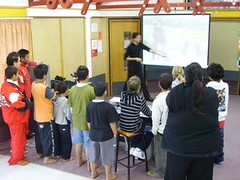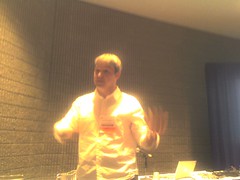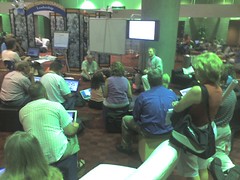 I saw this story in USAToday, while in Atlanta, but wasn’t able to pull it up until I found the original source, (First-Ever State-By-State Report on Internet Connection Speed Shows U.S. Far Behind Other Industrialized Nations) just a minute ago — a report from the Communications workers of America. It’s important to note that the union has a vested interest in working to increase Internet speeds in the U.S.
I saw this story in USAToday, while in Atlanta, but wasn’t able to pull it up until I found the original source, (First-Ever State-By-State Report on Internet Connection Speed Shows U.S. Far Behind Other Industrialized Nations) just a minute ago — a report from the Communications workers of America. It’s important to note that the union has a vested interest in working to increase Internet speeds in the U.S.
The first paragraph of the report reads…
Washington, DC.—Results released today (Jun 25, 2007) of the first-ever state-by-state report on Internet connection speed reveal that the United States is falling far behind other industrialized nations. The report, based on aggregated data from nearly 80,000 users, shows that the median real-time download speed in the U.S. is a mere 1.9 megabits per second (mbps). The best available estimates show average download speeds in Japan of 61 mbps, in South Korea of 45 mbps, in France of 17 mbps and in Canada of 7 mbps.
I extracted the data from the PDF file, and imported it into an MS Excel spreadheet. You can get it here. The top 10 states (fasted) for download speeds are:
- Rhode Island
- Kansas
- New Jersey
- New York
- Massachusetts
- Louisiana
- Georgia
- New Hampshire
- Delaware
- Maryland
The bottom ten (slowest) are:
- Arkansas
- Utah
- Idaho
- Montana
- North Dakota
- Iowa
- Wyoming
- West Virginia
- South Dakota
- Alaska
“First-Ever State-By-State Report on Internet Connection Speed Shows U.S. Far Behind Other Industrialized Nations.” CWA. 25 Jun 2007. Communications Workshops of America. 30 Jun 2007 <http://www.cwa-union.org/news/page.jsp?itemID=28663094>.


 Just home from NECC 2007 and a side trip to Columbia for an all-day workshop with technology and media educators, and administrators from Richland Two School District, and scanning through some of the buzz about this years mega conference — only to run across a very interesting conference put on by a small school in New Zealand,
Just home from NECC 2007 and a side trip to Columbia for an all-day workshop with technology and media educators, and administrators from Richland Two School District, and scanning through some of the buzz about this years mega conference — only to run across a very interesting conference put on by a small school in New Zealand, 


 I’m in a session about programming with Michael Kolling. He works for Kent University in Canterbury, England, but actually from Germany, as evidence by the two little dots over the “O” in his last name, which I can’t figure out how to make with my blog editor.
I’m in a session about programming with Michael Kolling. He works for Kent University in Canterbury, England, but actually from Germany, as evidence by the two little dots over the “O” in his last name, which I can’t figure out how to make with my blog editor. I was just walking through the hall with my friend Yvonne Hallman, and it occurred to me how much learning is going on here. You’re either in-session or in-world. You are either having fantastic conversations in the hall, or engaged in one of the poster session or the new lounges. Right out side the room I’m in right now (B303 Avatars) is what looks like an impromptu session, where people are sitting on the floor, on sofas, standing and leaning. You can’t turn around here without learning.
I was just walking through the hall with my friend Yvonne Hallman, and it occurred to me how much learning is going on here. You’re either in-session or in-world. You are either having fantastic conversations in the hall, or engaged in one of the poster session or the new lounges. Right out side the room I’m in right now (B303 Avatars) is what looks like an impromptu session, where people are sitting on the floor, on sofas, standing and leaning. You can’t turn around here without learning.